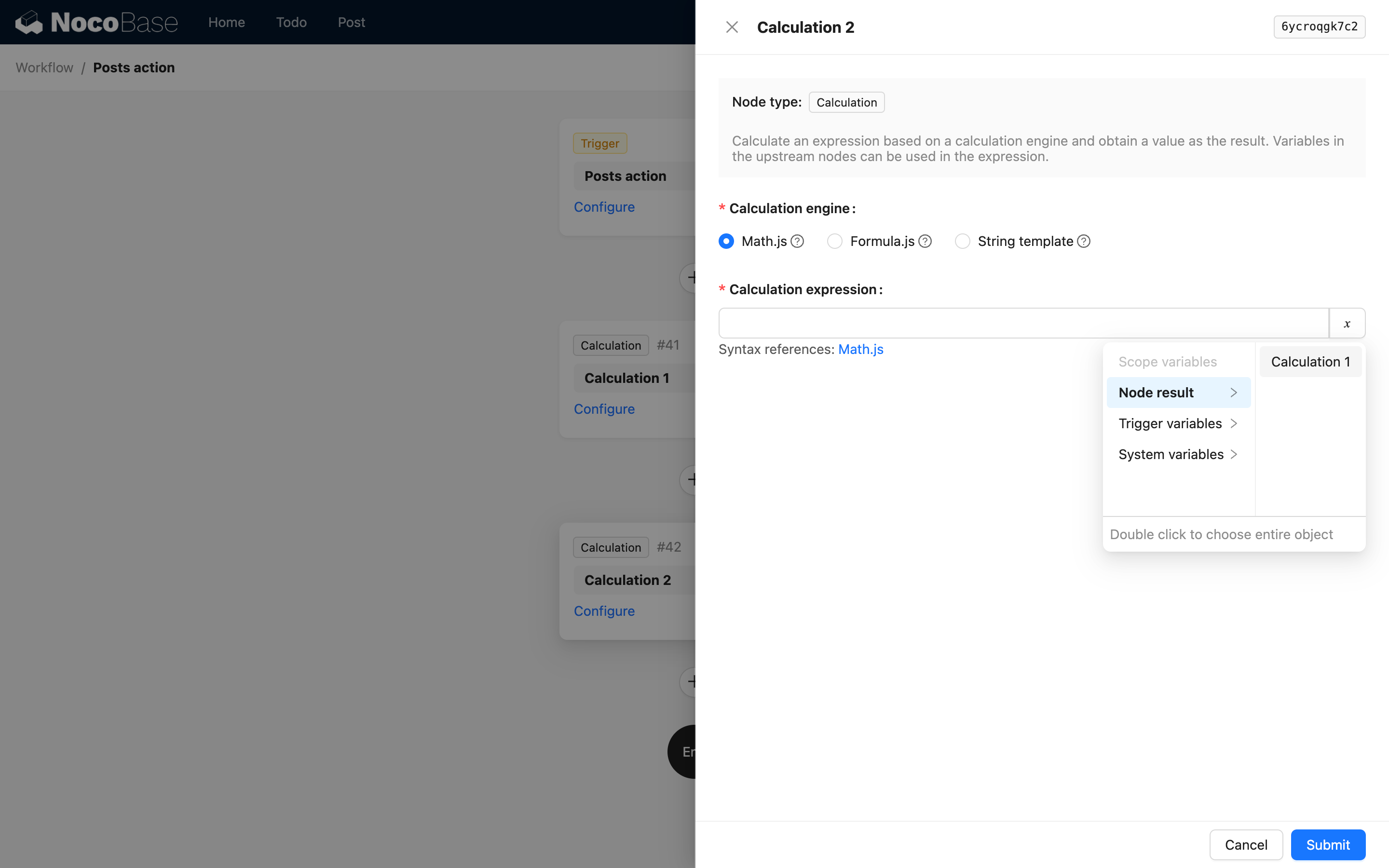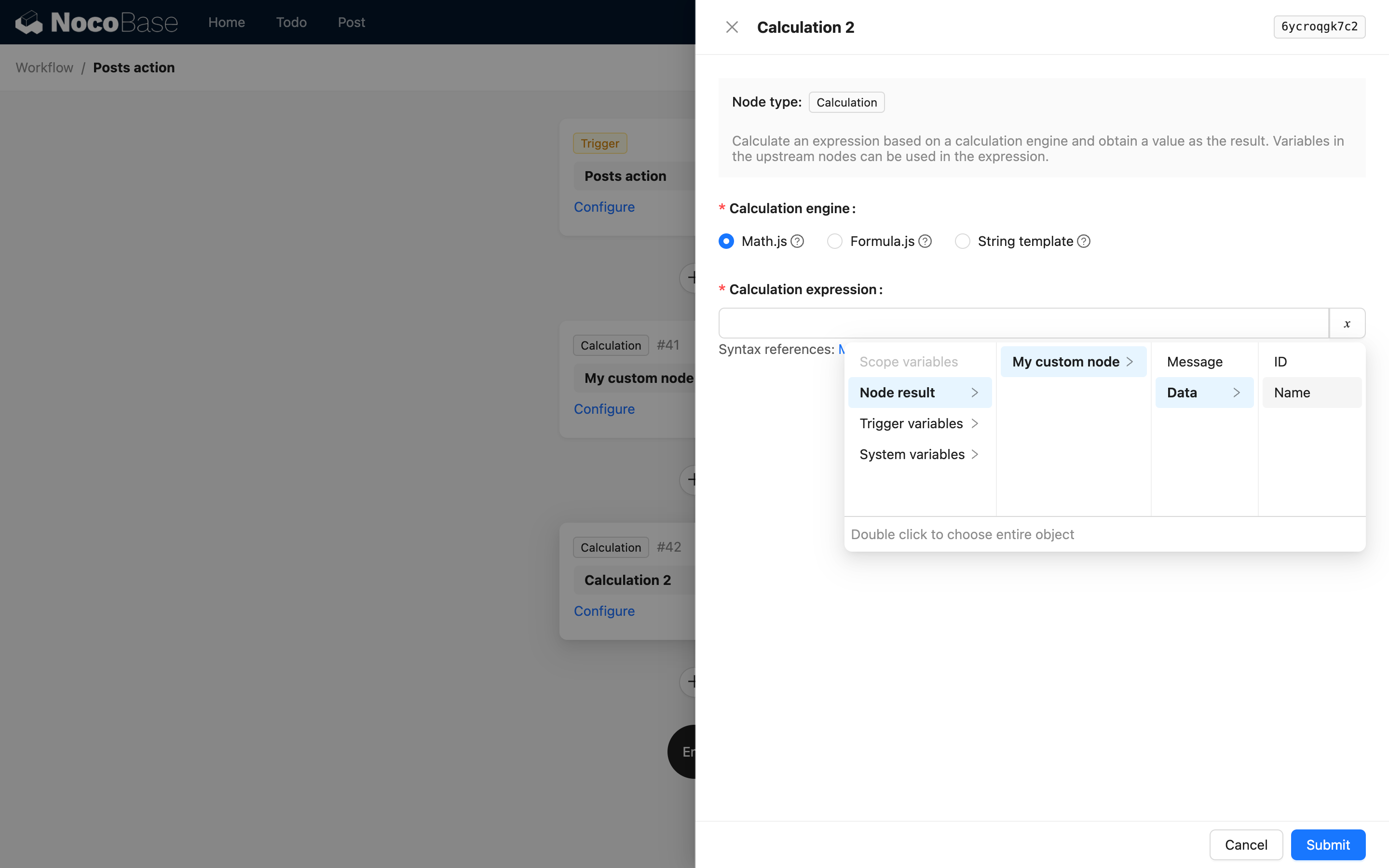Extending Node Types
A node's type is essentially an operational instruction. Different instructions represent different operations executed in the workflow.
Similar to triggers, extending node types is also divided into two parts: server-side and client-side. The server-side needs to implement the logic for the registered instruction, while the client-side needs to provide the interface configuration for the parameters of the node where the instruction is located.
Server-side
The Simplest Node Instruction
The core content of an instruction is a function, meaning the run method in the instruction class must be implemented to execute the instruction's logic. Any necessary operations can be performed within the function, such as database operations, file operations, calling third-party APIs, etc.
All instructions need to be derived from the Instruction base class. The simplest instruction only needs to implement a run function:
And register this instruction with the workflow plugin:
The status value (status) in the instruction's return object is mandatory and must be a value from the JOB_STATUS constant. This value determines the flow of subsequent processing for this node in the workflow. Typically, JOB_STATUS.RESOVLED is used, indicating that the node has executed successfully and the execution will continue to the next nodes. If there is a result value that needs to be saved in advance, you can also call the processor.saveJob method and return its return object. The executor will generate an execution result record based on this object.
Node Result Value
If there is a specific execution result, especially data prepared for use by subsequent nodes, it can be returned through the result property and saved in the node's job object:
Here, node.config is the node's configuration item, which can be any required value. It will be saved as a JSON type field in the corresponding node record in the database.
Instruction Error Handling
If exceptions may occur during execution, you can catch them in advance and return a failed status:
If predictable exceptions are not caught, the workflow engine will automatically catch them and return an error status to prevent uncaught exceptions from crashing the program.
Asynchronous Nodes
When flow control or asynchronous (time-consuming) I/O operations are needed, the run method can return an object with a status of JOB_STATUS.PENDING, prompting the executor to wait (suspend) until some external asynchronous operation is completed, and then notify the workflow engine to continue execution. If a pending status value is returned in the run function, the instruction must implement the resume method; otherwise, the workflow execution cannot be resumed:
Here, paymentService refers to a payment service. In the service's callback, the workflow is triggered to resume the execution of the corresponding job, and the current process exits first. Later, the workflow engine creates a new processor and passes it to the node's resume method to continue executing the previously suspended node.
The "asynchronous operation" mentioned here does not refer to async functions in JavaScript, but rather to non-instantaneous return operations when interacting with other external systems, such as a payment service that needs to wait for another notification to know the result.
Node Result Status
The execution status of a node affects the success or failure of the entire workflow. Typically, without branches, the failure of a node will directly cause the entire workflow to fail. The most common scenario is that if a node executes successfully, it proceeds to the next node in the node table until there are no more subsequent nodes, at which point the entire workflow completes with a successful status.
If a node returns a failed execution status during execution, the engine will handle it differently depending on the following two situations:
-
The node that returns a failed status is in the main workflow, meaning it is not within any branch workflow opened by an upstream node. In this case, the entire main workflow is judged as failed, and the process exits.
-
The node that returns a failed status is within a branch workflow. In this case, the responsibility for determining the next state of the workflow is handed over to the node that opened the branch. The internal logic of that node will decide the state of the subsequent workflow, and this decision will recursively propagate up to the main workflow.
Ultimately, the next state of the entire workflow is determined at the nodes of the main workflow. If a node in the main workflow returns a failure, the entire workflow ends with a failed status.
If any node returns a "pending" status after execution, the entire execution process will be temporarily interrupted and suspended, waiting for an event defined by the corresponding node to trigger the resumption of the workflow. For example, the Manual Node, when executed, will pause at that node with a "pending" status, waiting for manual intervention to decide whether to approve. If the manually entered status is approval, the subsequent workflow nodes will continue; otherwise, it will be handled according to the failure logic described earlier.
For more instruction return statuses, please refer to the Workflow API Reference section.
Early Exit
In some special workflows, it may be necessary to end the workflow directly within a node. You can return null to indicate exiting the current workflow, and subsequent nodes will not be executed.
This situation is common in flow control type nodes, such as the Parallel Branch Node (code reference), where the current node's workflow exits, but new workflows are started for each sub-branch and continue to execute.
:::warn{title=Note} Scheduling branch workflows with extended nodes has a certain complexity and requires careful handling and thorough testing. :::
Learn More
For the definitions of various parameters for defining node types, see the Workflow API Reference section.
Client-side
Similar to triggers, the configuration form for an instruction (node type) needs to be implemented on the client-side.
The Simplest Node Instruction
All instructions need to be derived from the Instruction base class. The related properties and methods are used for configuring and using the node.
For example, if we need to provide a configuration interface for the random number string type (randomString) node defined on the server-side above, which has a configuration item digit representing the number of digits for the random number, we would use a number input box in the configuration form to receive user input.
The node type identifier registered on the client-side must be consistent with the one on the server-side, otherwise it will cause errors.
Providing Node Results as Variables
You may notice the useVariables method in the example above. If you need to use the node's result (the result part) as a variable for subsequent nodes, you need to implement this method in the inherited instruction class and return an object that conforms to the VariableOption type. This object serves as a structural description of the node's execution result, providing variable name mapping for selection and use in subsequent nodes.
The VariableOption type is defined as follows:
The core is the value property, which represents the segmented path value of the variable name. label is used for display on the interface, and children is used to represent a multi-level variable structure, which is used when the node's result is a deeply nested object.
A usable variable is represented internally in the system as a path template string separated by ., for example, {{jobsMapByNodeKey.2dw92cdf.abc}}. Here, jobsMapByNodeKey represents the result set of all nodes (internally defined, no need to handle), 2dw92cdf is the node's key, and abc is a custom property in the node's result object.
Additionally, since a node's result can also be a simple value, when providing node variables, the first level must be the description of the node itself:
That is, the first level is the node's key and title. For example, in the calculation node's code reference, when using the result of the calculation node, the interface options are as follows:

When the node's result is a complex object, you can use children to continue describing nested properties. For example, a custom instruction might return the following JSON data:
Then you can return it through the useVariables method as follows:
This way, in subsequent nodes, you can use the following interface to select variables from it:

When a structure in the result is an array of deeply nested objects, you can also use children to describe the path, but it cannot include array indices. This is because in NocoBase workflow's variable handling, the variable path description for an array of objects is automatically flattened into an array of deep values when used, and you cannot access a specific value by its index.
Node Availability
By default, any node can be added to a workflow. However, in some cases, a node may not be applicable in certain types of workflows or branches. In such situations, you can configure the node's availability using isAvailable:
The isAvailable method returns true if the node is available, and false if it is not. The ctx parameter contains the context information of the current node, which can be used to determine its availability.
If there are no special requirements, you do not need to implement the isAvailable method, as nodes are available by default. The most common scenario requiring configuration is when a node might be a time-consuming operation and is not suitable for execution in a synchronous workflow. You can use the isAvailable method to restrict its use. For example:
Learn More
For the definitions of various parameters for defining node types, see the Workflow API Reference section.

